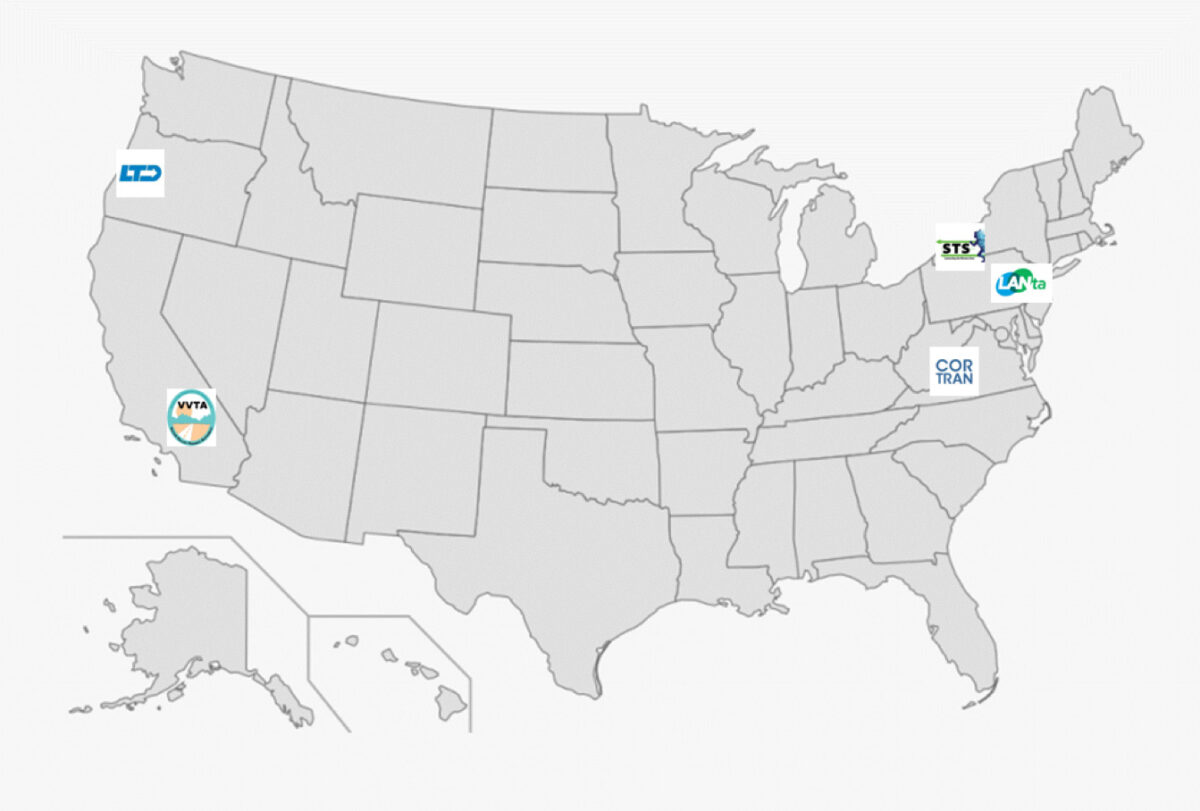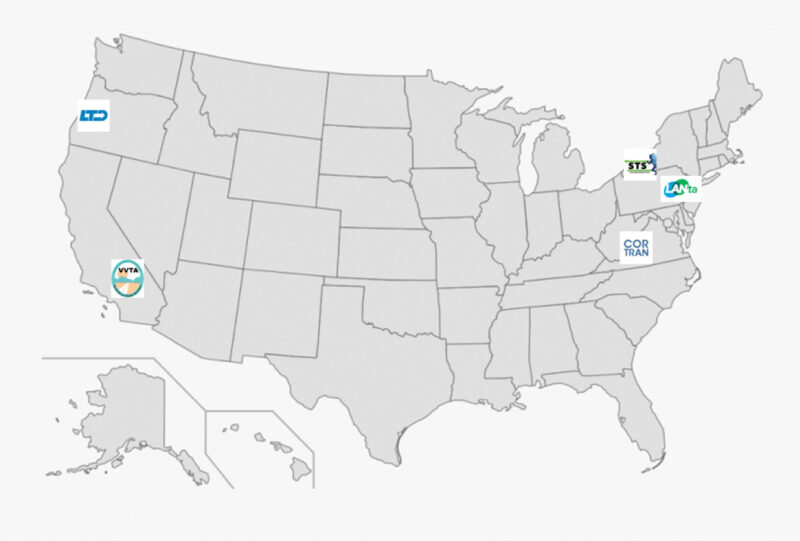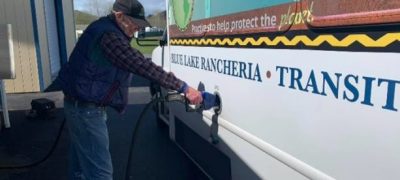
Passive Data Collection Passive Data Collection Case Studies
- Date: January 5, 2023
Jump to section
Five transit agencies – that range in geography, size, and services offered – were interviewed to provide case studies on how agencies are using passive data collection systems.
The interviewed agencies included Victor Valley Transit Authority (VVTA) in California, CORTRAN in Roanoke, Virginia, the Lehigh and Northampton Transportation Authority (LANta) in the Lehigh Valley in Pennsylvania, Lane Transit District (LTD) in Eugene, Oregon, and Seneca Transit System in western New York.
As shown in Table 2, the National Transit Database (NTD) information has been provided for each transit agency participating in the case study interviews. The ridership (in terms of annual unlinked trips), vehicle revenue miles (VRM), vehicle revenue hours (VRH), vehicles operated in maximum service (VOMS), and operating funds expended have been defined. For VOMS, both the number of buses and the demand response (DR) total have been provided for reference, along with other modes if applicable.
| Agency | Ridership | VRM | VRH | VOMS | Operating $ Expended |
| CORTRAN | 13,840 | 173,958 | 13,580 | 4 (DR) | $790,278 |
| Lane Transit District | 8,533,030 | 7,067,504 | 437,933 | 134 (DR)
86 (bus/BRT) 16 (vanpool) |
$54,346,157 |
| LANta | 4,036,833 | 4,964,631 | 358,144 | 82 (DR)
78 (bus) |
$37,725,778 |
| Seneca Transit | 12,463 | 203,699 | 5,682 | 2 (bus) | $558,494 |
| Victor Valley Transit Authority | 1,971,684 | 9,146,033 | 333,612 | 42 (DR)
53 (bus) 224 (vanpool) |
$24,148,955 |
These agencies and their locations are shown in the map below:
These agencies provide services ranging from demand-response service utilizing contracted vehicles to fixed route systems. They also currently collect and utilize varying degrees of passive data and have clientele ranging from only seniors and those with disabilities, as is case with CORTRAN, to largely students and “essential” workers, as is the case with LTD and LANta.
The following sections will outline the current “use case” practices, applications of available technologies, tradeoffs, data sharing concerns, challenges, and some next steps associated with passive data for the agencies.
Current Practices/Applications of Technology
All the interviewed agencies utilize passive data; however, there is significant variety in the quantity and level of detail being collected. VVTA, LTD, and LANta have computer-aided dispatch/automatic vehicle locator (CAD/AVL) systems and automatic passenger counters (APCs) on all buses, though the APCs are not certified for use in gathering data for the National Transit Database (NTD) at VVTA. The combination of CAD/AVL systems and APCs gather boarding data, passenger load data, as well as stop-level data. The data is utilized to analyze performance and ridership and then develop data-driven solutions to provide the most benefit to the largest number of riders. The AVL systems are also able to track sudden changes in speed that indicate extreme acceleration or braking, which can provide data in cases where there is an incident or even if a vehicle’s fuel consumption is outside of optimal parameters.
While Seneca Transit does not have APCs on their vehicles, the agency does use the “Passio GO!“ AVL and rider mobile app system that records passenger load and shows vehicle location through an online portal; this data is available in real-time as well as for later reference in cases of an incident. While the AVL records vehicle location, Seneca Transit utilizes active data collection to obtain passenger boarding information by having the driver push a button each time someone boards. This data is sent automatically to the agency. They use Passio GO! to eliminate the use of paper ridership data collection.
CORTRAN partners with Via to provide demand response transit. While Via is the vehicle operator, the vehicles are leased by a third party. Technology on the vehicles is limited to drivers using their own personal devices and the only data provided to the agency is from a report generated by Via.
The availability of data is continuing to increase, and some agencies are including vehicle health monitoring systems (sometimes referred to as “telematic” systems) on their vehicles. These are particularly relevant for electric vehicles. LTD indicated that they collect data from their electric buses on how quickly they are charging and the intensity of braking and accelerating. They currently have 10 electric buses but will soon have 30, dramatically increasing the available data from their fleet. Battery electric buses at VVTA also utilize a telematic system that passively collects data; however, this is not included on the compressed natural gas (CNG) buses. As an alternative to telematic systems, LANta has fuel pump and fluid software to capture how much fuel and fluids a bus is using at the point of delivery (on the service line). This is used to flag when a bus is outside of the target parameters, which triggers their maintenance department to inspect the bus.
Additional data can also be collected using apps that facilitate mobile ticketing. LANta is able to collect data from the fare payment app they use (Token Transit), which passengers can use to buy bus passes with their mobile phone, that provides data on when and where people are activating passes. This provides additional insights regarding demand for the transit system.
Staff Capacity Requirements and Needs
While the vendors that were interviewed indicated that their products are designed in a way that does not require additional staffing or data analytics backgrounds, the agencies overwhelmingly cited the heightened staffing needs associated with passive data systems. VVTA summarized this by stating “to accurately collect and use passive data, you need active monitoring and analysis.”
Anomalies in the data are not infrequent and require attention to gain beneficial insight from the data. LANta indicated that they do have the ability to handle technology support and data analysis internally, but it does require a lot of staffing resources. At LANta, the planning staff handle the majority of the data analysis, but they also have a committee that reviews route-level data to identify where issues exist and distinguish problems from anomalies. For example, at the end of a route a driver may move the bus to a certain location to take a layover, and the APC and CAD/AVL systems will record that the trip has begun early because the vehicle is moving when it should not be on a route.
The interviews with the transit agencies drove home the point that while trained data scientists or analysts might not be needed, there is a need for tech-savvy, data-oriented employees to monitor and review the data. As was indicated in the interviews with the vendors, it is important to have a “champion” for the technology who is trained and can take the lead on diagnosing data anomalies and repairing the hardware. LANta stated that they have access to a strong labor market, but it has been difficult to hire people who are intellectually curious enough to find and diagnose anomalies in the data. This was echoed by LTD, as they take pride in the sophistication of their passive data collection but continue to struggle with staffing. This has been magnified by labor shortages facing most of the country since the beginning of the pandemic. CORTRAN noted a similar situation, though at a smaller scale, stating that while their staff would like to have additional capacity in managing and analyzing the provided data, it isn’t possible at this time. Generally, it appears that agencies collect data to varying degrees and while they stay within their staffing capabilities, they typically find themselves pushed near the limit of what their resources allow in terms of being able to analyze and prepare data.
Benefits and Costs of Technologies
Systems that enable passive data collection can drastically increase the amount of data available to transit agencies and can contribute to data-driven solutions regarding route changes, stop frequency, trouble-shooting problem areas, and many other applications. However, these systems represent an expense for the agencies. Given the inevitability of cost constraints, all agencies will have to assess the tradeoffs between the perceived costs and the potential benefits of passive data collection. LTD found that the implemented passive data collection technologies converted costs from labor to capital expenditures. For example, they are able to save some resources by doing on-board counts with APCs rather than hand-counts, but now instead needed to purchase, calibrate and maintain the APCs.
Both LANta and VVTA reported exploring the potential of comprehensive vehicle health monitoring/telematic systems, but felt the cost was too high. VVTA considered installing telematic systems on the entirety of the bus fleet but ultimately found it was not a feasible option due to costs. They have had some issues in the past with drivers not following procedures, which has led to mechanical issues (e.g., overheating engines), so they do see the benefit of all buses having telematic systems, but the perceived benefits do not outweigh the potential costs. While LANta did not feel they should fund the installation of vehicle health monitoring systems themselves, PennDOT is paying to upgrade all buses on fixed routes within Pennsylvania using Avail. This will allow PennDOT to collect the same data from all transit systems.
While some passive data collections systems were deemed infeasible due to cost, the interviewed agencies emphasized that the focus of these systems should be on improved service and reliability instead of any potential cost savings. Rather than assessing the benefit of the passive data collection using a traditional benefit-cost analysis in which the benefits are monetized, the agencies shared cohesive feedback that it is not about saving money but about delivering a better product to its customers. The data provided and the speed in which that data is provided allows agencies to make adjustments more dynamically. Seneca Transit noted that the motivation for employing the Passio system was improved accuracy of data. LANta noted that while cost savings may have been an initial motivation, they realized this is not actually an outcome. For example, with the installation of data collection systems, they thought they would not need supervisors in the field. However, this was not the case as the systems do not have the ability to interact with upset customers, change parking/layover accommodations, and many other needs that regularly require the presence of a trained professional. They iterated that the systems do help with the reliability and performance of the systems and, therefore, helps in delivering their mission – but they did not necessarily save resources. There is now less focus on using passive data collection systems to save money than using it to make sure the best service possible is provided.
Data Sharing
With an increase in available data, agencies must determine the degree to which they want and are able to share data. This varies based on the agency, the contracts they hold, and policies in their respective geographies. For example, although the contract that CORTRAN holds with Via states that no ridership data can be shared with researchers or the public, other agencies such as VVTA and Seneca Transit have faced no issues with sharing data. VVTA indicated that since the data is their operating data, it is theirs to use and distribute as they please; however, they did indicate that there has been some push-back with the battery electric buses over concern that information could be gathered without the VVTA’s approval.
Data privacy is a key concern for the transit agencies. To protect sensitive data CORTRAN reported that all data is anonymized, and LANta does not share any data from their paratransit system due to HIPPA protections. While LTD noted that data privacy is a key concern, they also indicated that Oregon has very strong open records laws, so there is not a lot of flexibility to keep data secret unless it would cause a specific privacy issue. LANta also discussed being subject to right-to-know laws. If they have a system that is collecting data and automatically generates a report, they would have to share this data if someone submitted a right-to-know request. For this reason, they do not upload all camera footage automatically; instead, they manually get footage if there is an incident. With this practice, they are able to cite that they do not normally store this footage, so they are not required to get the footage solely for a random request.
Challenges
While passive data collection can allow agencies to provide a more efficient and reliable service, it does not come without challenges even outside those of cost and staffing capabilities. One difficulty that was noted with APCs is that they must regularly be manually calibrated or reset, which introduces room for error. This then introduces, for example, the question of whether failing to reset the APCs at the start of a route is worth disciplining drivers. Issues were reported by VVTA regarding compatibility and support with the APCs since they switched to their new CAD/AVL system. They are currently in the process of upupdating all the APCs due to this lack of compatibility and recommend that agencies always procure APC and CAD/AVL as a joint purchase. While there is significantly more data when using passive data collection systems, there are still shortcomings that limit the usage. CORTRAN noted that while data collection is easier with their contract with Via, their portal only provides data from recent months, meaning older data is still not easily accessible. LTD reported that while the data can be helpful for planning purposes, the data they obtained from StreetLight Data has margins of error that are large enough to make it challenging at times to use the data in the context of transit planning.
Seneca Transit reported challenges understanding how the data is obtained, transmitted, and reported. The Passio system does not provide any information other than ridership to the agency. They also utilize their contractor (First Transit) to track preventive maintenance activities, but they are not sure what methodology is used for this tracking.
As was indicated in the interviews with the vendors, the agencies have also faced challenges in establishing “buy-in” for the uses and types of data they collect. LANta reported that dispatchers frequently see issues reported by the data collection systems but do not report them because it happens on a regular basis. They tend to assume the system is wrong, so they do not react to the data in front of them. This presents a challenge as those in operations are the people who can use the information to impact the overall quality of the service. CORTRAN also reported instances in which passengers disagree with the routes that are recommended by the mapping technology, leaving drivers to determine if they should trust the generated route or take the route requested by the riders.
While there are numerous challenges associated with data collection, the agencies do largely report that it allows them to provide a better service to their clients. LTD stated that “for small- and medium-sized agencies, collecting this data is hard but worth it. They get a lot of value for their money even though it’s really challenging.”
Conclusion: Goals and Next Steps for Passive Data Collection Technology
As the agencies continue to expand their competency in data collection, management, and utilization, they are also looking at other areas that could benefit from more modern technology and data collection. One area that agencies would like to improve is the efficiency of fare collection and ticketing. This includes taking steps to encourage online ticketing rather than having riders use cash, as collecting cash on the buses is onerous. Seneca Transit had been exploring touch free/mobile ticketing but suspended further investigation due to COVID. However, the pandemic has made them question whether the cost of collecting fares is worth the administrative effort of collecting and counting cash, in addition to the operational delays due to people counting out change at the farebox.
Improvements to staffing capabilities is also something agencies would like to improve. Several of the agencies expressed issues regarding finding and retaining highly qualified staff. LTD is considering offering options such as allowing people to work remotely as a strategy to recruit talent.
The availability of data will continue to increase as technology progresses and electric vehicles become more commonplace in transit fleets. Agencies will be tasked with finding a balance between utilizing the available data to improve their systems and staffing and funding limitations. There will inevitably be redundancy in what the various technologies and data collection systems can offer and what drivers and maintenance employees already provide to agencies. Agencies will need to determine what types of data collection provide new and useful information as well as where data collection provides necessary redundancy that improves operations and maintenance capabilities. While case-studies and lessons-learned from other agencies can inform these decisions, it will ultimately be unique to each agency.

